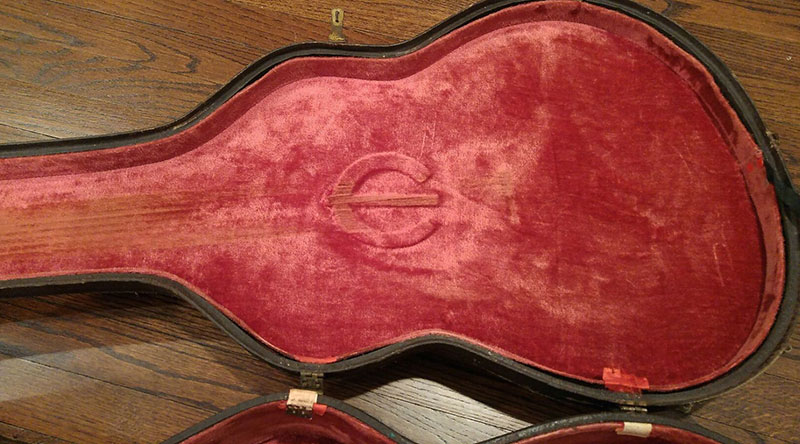
Close-up #43: "E"-logo cases and their manufacturers 1939–1956
Epiphone was a pioneer in having their instrument cases branded with their logo – a letter "E" embossed in the lining of the lid –, first announced in the 1939 catalog (see picture below). Let's have a closer look at these beautiful cases and their details. Note that only hardshell cases had the "E"-logo – while the cheaper chipboard cases were not Epiphone-branded, and are not discussed here.
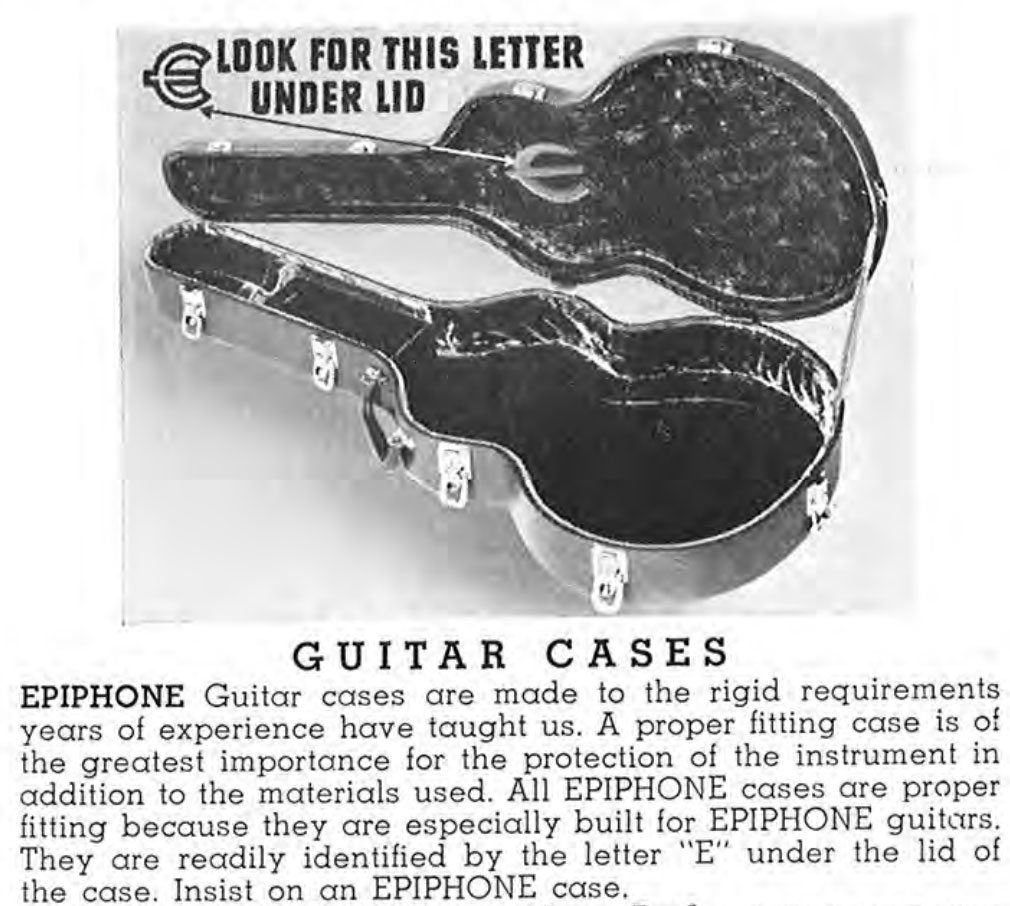
What I try to figure out in this excercise: Can we pin down any pattern regarding manufacturers, case models/sizes and time periods?
A note on "originality"
Vintage guitars are often described as having an "original case". But what does "original" really mean? Cases wear out and tend to get replaced during the lifetime of an instrument – often by another older case that fits the instrument. So when an old Epiphone guitar comes with an old "E"-logo case, the two items may actually have been combined later in their life – i.e.: while the case is a vintage original Epiphone item, it may not be the one the guitar was originally sold with. Quite often a closer look reveals that an instrument and its case may be from slightly different periods.
Another "originality" question: What about 1939–1956 Epiphone instruments housed in a period case without "E"-logo? Non-original case? Not necessarily: From what we know, cases were usually sold by music stores as a separate accessory – and often an Epiphone retailer may also have carried other case model lines than the "E"-logo versions recommended by the instrument manufacturer. So when a 1940–50s Epiphone instrument comes in a period hardshell case without "E"-logo, it may still be the very case it was originally sold with by the dealer.
Such caveats have to be taken into account – also when dating a case based on the instrument it came with.
Case options – sizes and time periods
When the "E"-logo cases were introduced in the 1939 catalog, they were offered in an almost confusing variety:
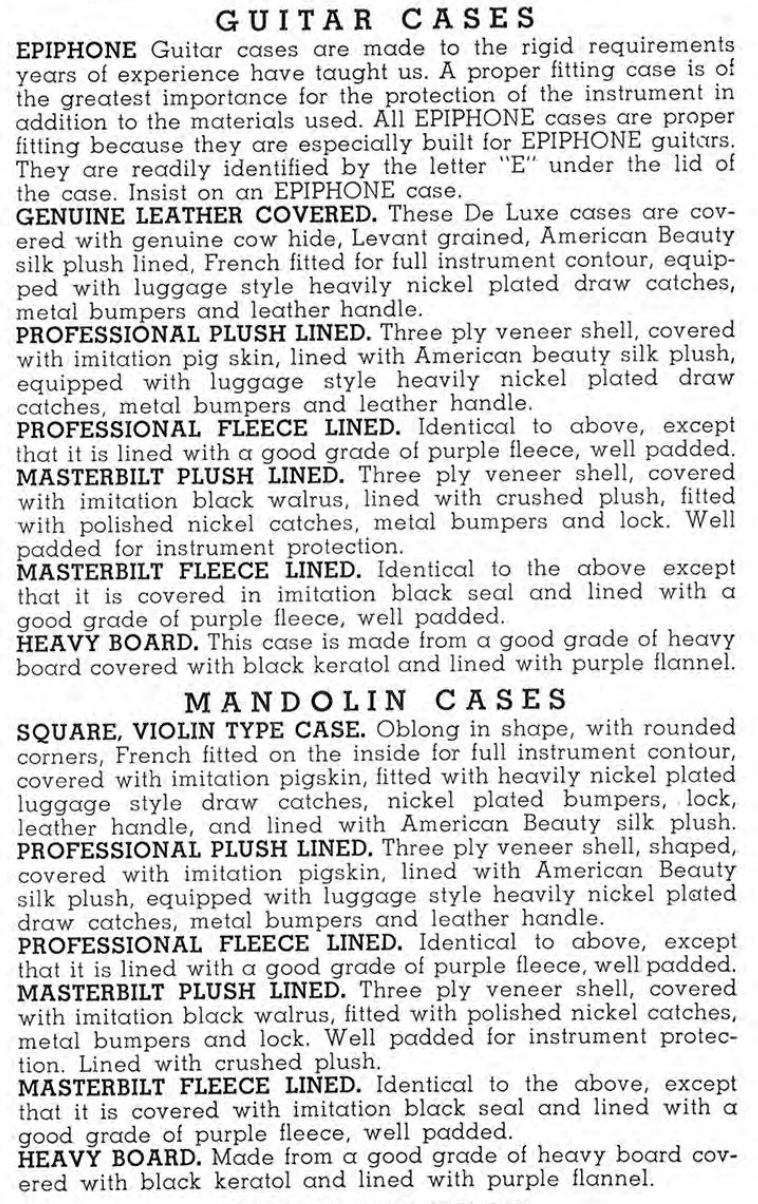
However note that not every listed case option was available in every instrument size. And after WW2 the case models were significantly reduced. Below an overview – based on catalogs/pricelists and documented examples in my image library:
- Genuine leather covered cases / deluxe cases: Cases with genuine leather covering were available in size 18" (No. 115, included with Emperor until 1941, see catalog picture below) and 17" (No. 985). Interior was plush with neck rest at headstock, typically with a form-fitted heel area.
Soon after WW2, genuine leather covered models were discontinued and replaced by deluxe cases with imitation leather covering (18" No. 110, and 17" No. 105). These deluxe cases typically had plush lining, neck rest block, draw catches, and by 1948 featured a lid with stitched valance.
The imitation leather cover material used for Epiphone cases was keratol (textile fabric coated with linseed oil and celluloid).
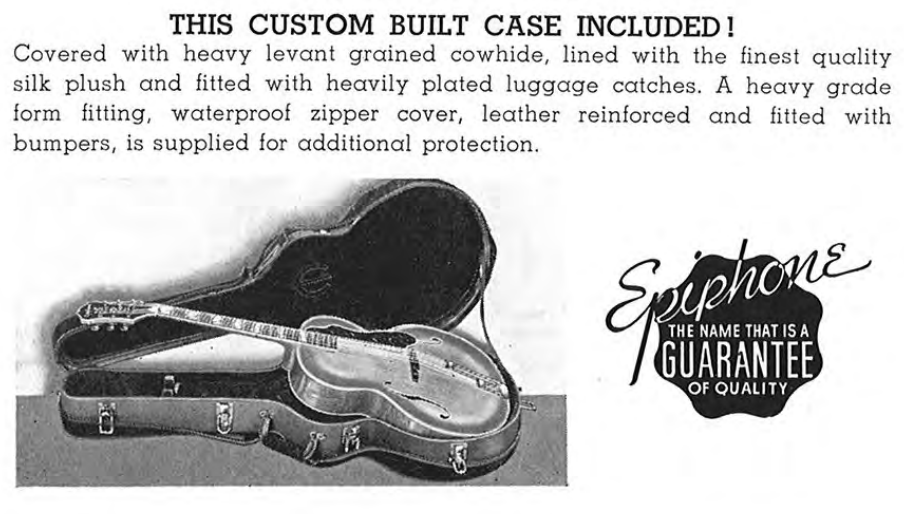
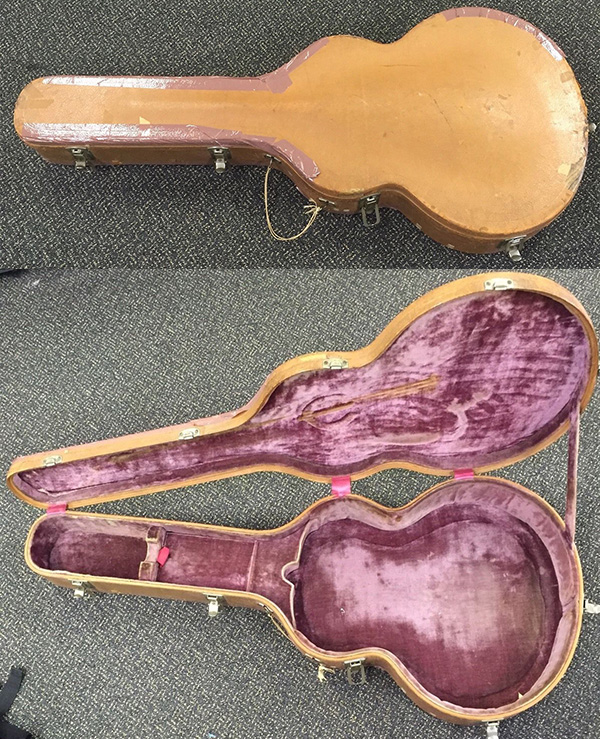
Above: Case No. 115, 18", genuine leather covered, plush lining, neck rest at headstock, form-fitted heel area, draw catches/lock (came with 1941 Emperor); manufactured by Geib; note "E"-logo in upper bout of lid.
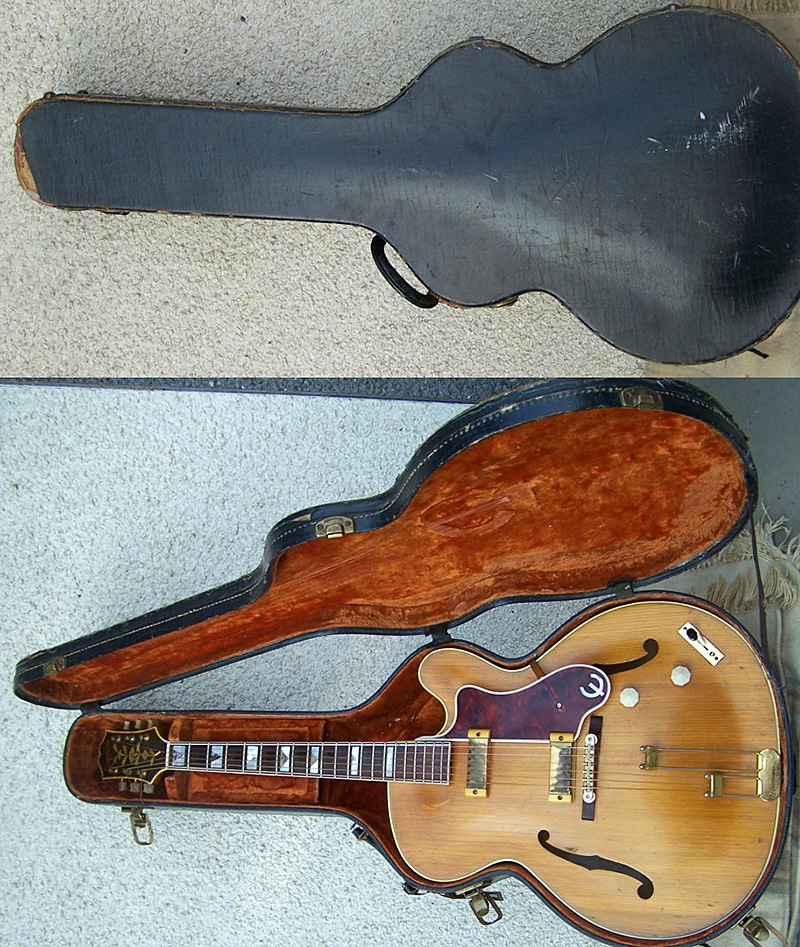
Above: Case No. 105, 17", alligator-style keratol covered, plush lining, neck rest at headstock, stitched lid valance, draw catches/lock (with 1950 Zephyr DeLuxe Regent); manufactured by Harptone; note "E"-logo in waist area of the lid.
- "Professional" cases: Imitation leather covered; the 1939 and 1942 catalogs described nickel-plated draw catches and draw lock; postwar examples typically had spring catches and spring lock. Most examples feature a neck rest block – placed either at the headstock or near the heel, depending on year and manufacturer (exception: typically no neck rest in the mid-to-late 1940s).
The better version had plush lining, available for 17", 16" and FT Jumbo guitars (No. 885/884/855). These were the most common Epiphone hardshell cases of the 1940–50s era.
A cheaper variant with flannel fleece lining (No. 785 in 17" size) was discontinued by 1941.

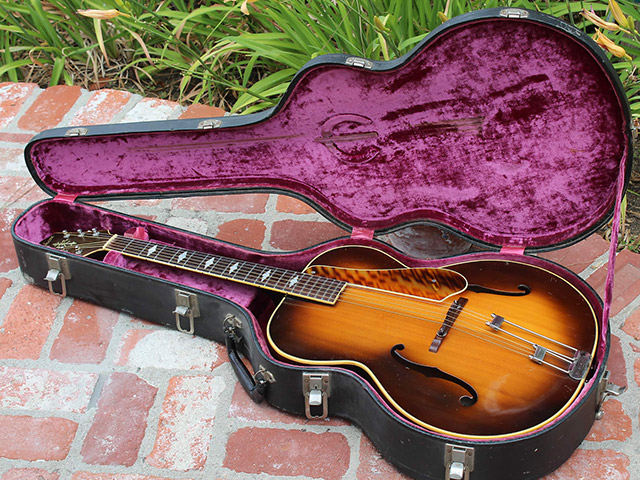
Above: "Professional" series case No. 885, 17", alligator-style keratol covered, plush lining, neck rest at headstock, draw catches/lock (with 1940 Triumph); manufactured by Geib; note "E"-logo in upper bout of lid.
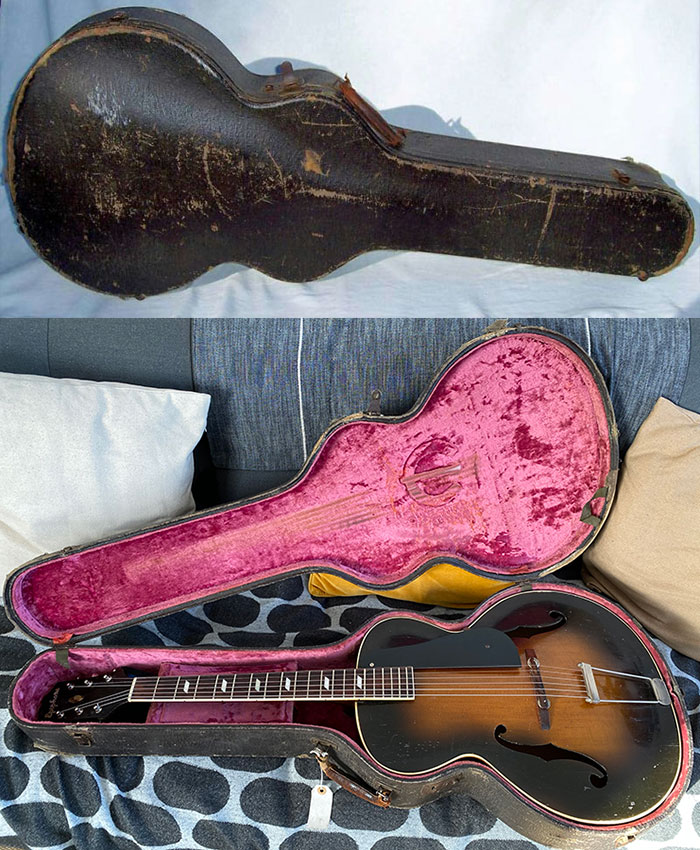
Above: "Professional" series case No. 884, 16", keratol covered, plush lining, no neck rest, spring catches/lock (with
1948 Blackstone); manufactured by Harptone; note "E"-logo in waist area of lid.
- "Masterbilt" cases: Imitation leather covered, featuring spring catches/lock, no neck rest block.
The better version was lined with crushed (curly) plush, available for 17", 16", 15" archtop (No. 685/684/683) and flattop/Hawaiian acoustic guitars (No. 755/637/627/HA2).
The cheaper version was lined with flannel fleece, available for 17", 16", 15" archtop (No. 585/584/583) and all flattop/Hawaiian acoustic guitars (No. 655/537/527/HA1).
The "Masterbilt" budget hardshell case line was discontinued by 1945.
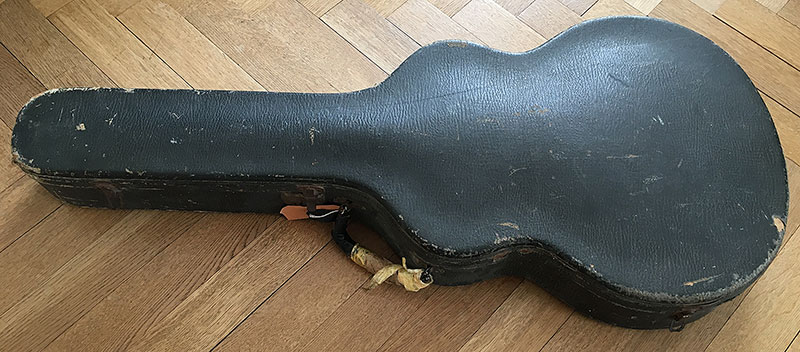
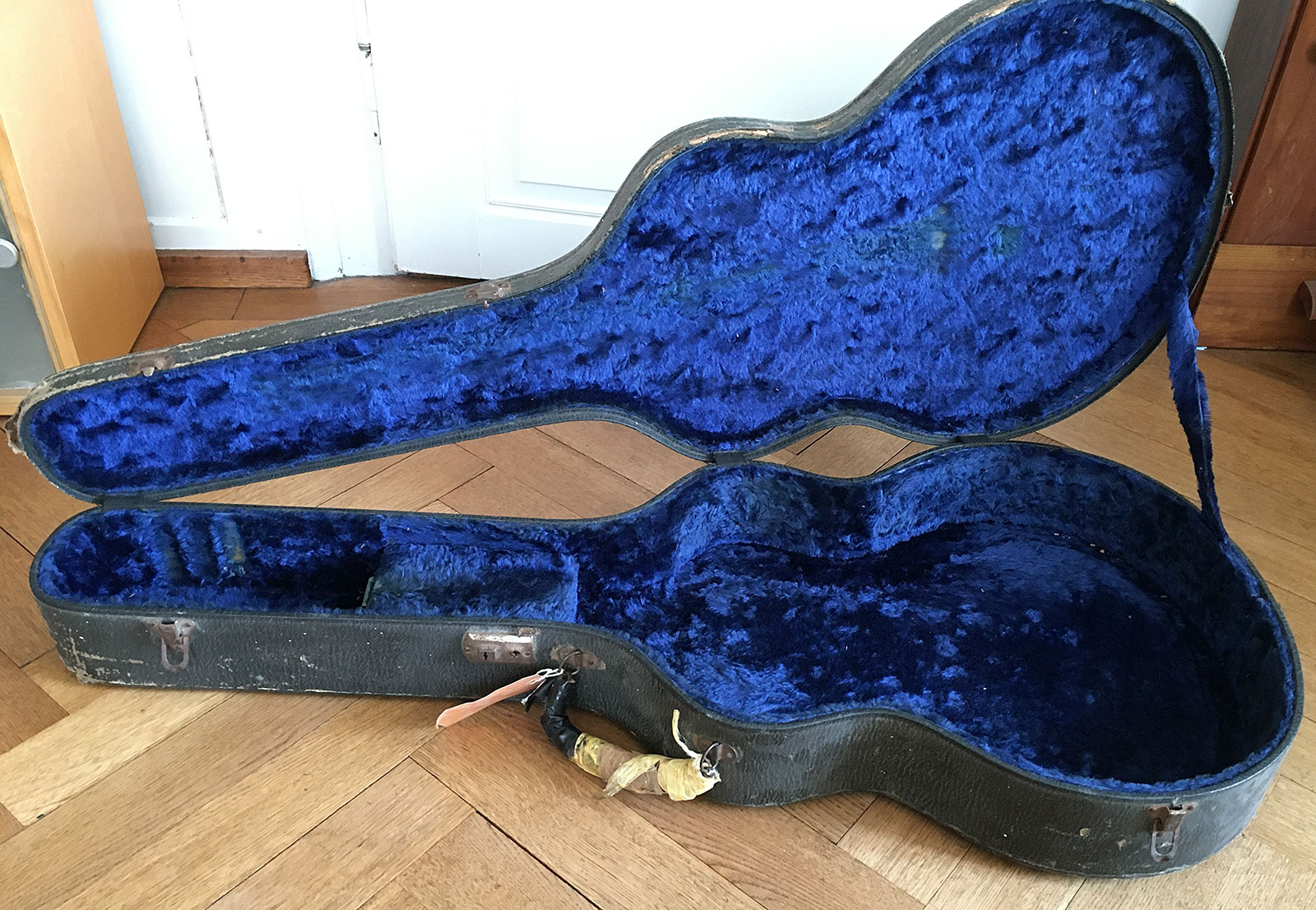
Above: "Masterbilt" series case No. 685, 17", keratol covered, crushed plush lining, no neck rest (came with 1940 Triumph); manufactured by Lifton; note "E"-logo in upper bout of lid (hard to see in the curly plush, but you feel the raised logo when touching).
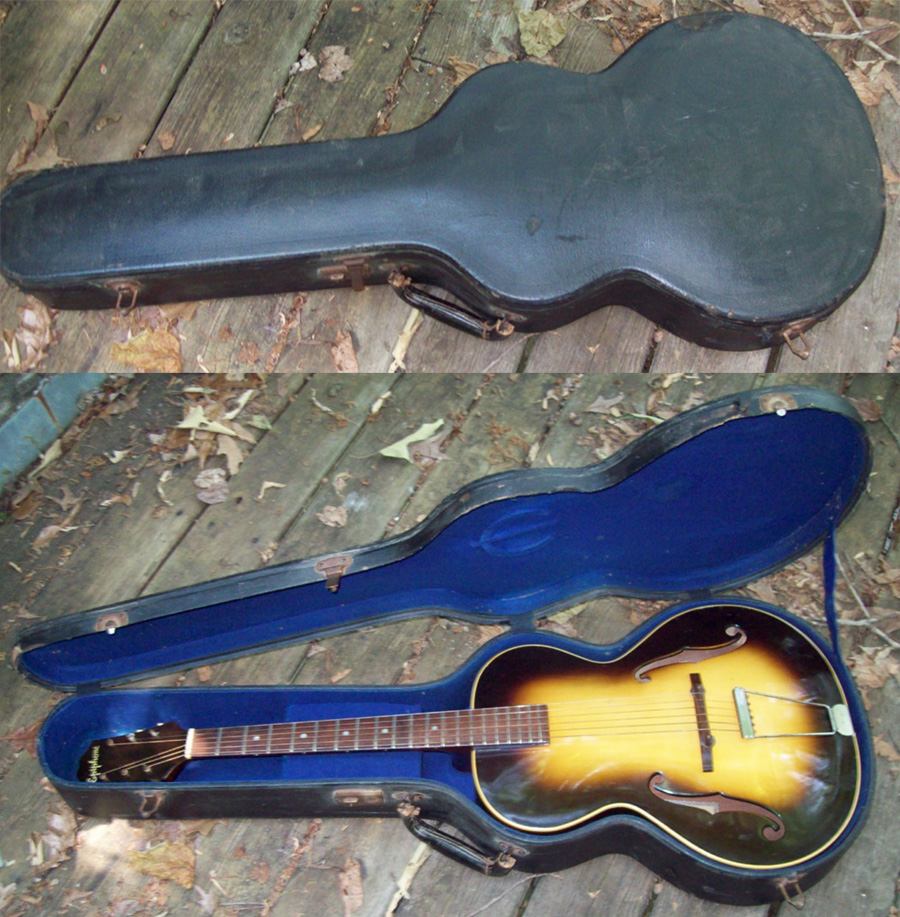
Above: "Masterbilt" series case No. 583, 15", keratol covered, fleece lining, no neck rest (with 1944 Olympic); manufactured by Lifton; note "E"-logo in upper bout of lid.
Mandolins: for models with teardrop or two-point body shape, cases with plush lining (No. 632) and fleece lining (No. 532) were offered. For the high-end models with scroll body, there was a choice between two oblong deluxe cases with form-fitted interior (No. 830 with plush lining and draw locks, and the cheaper No. 831 with crushed plush/spring locks) – see picture in 1939 catalog below.
After WW2, only the plush lined case No. 632 remained, typically without "E"-logo under the lid.
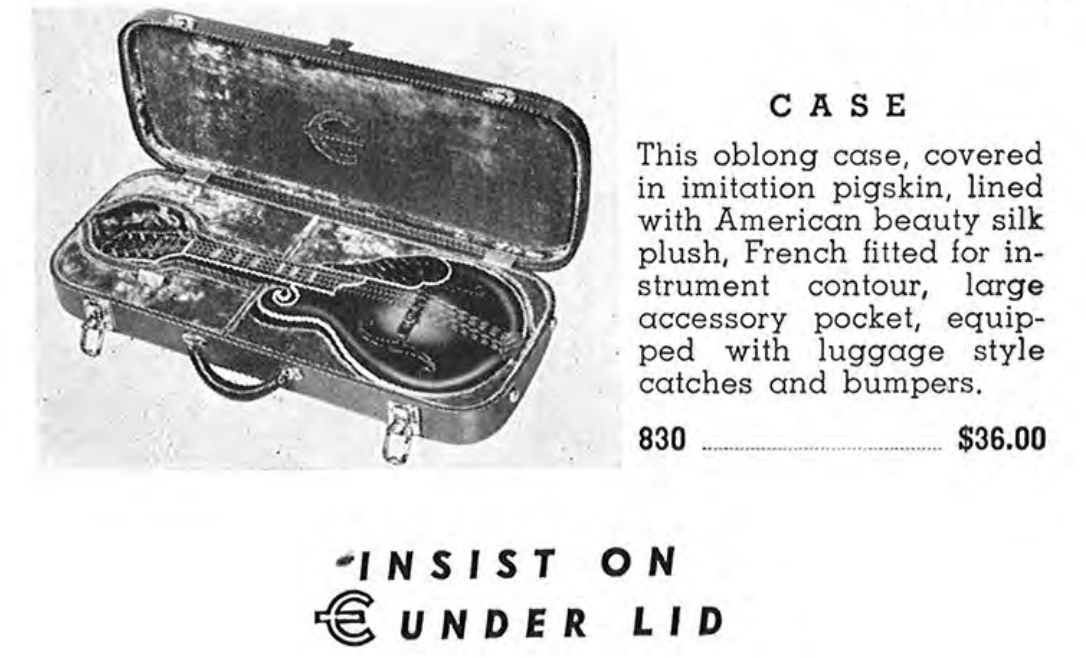
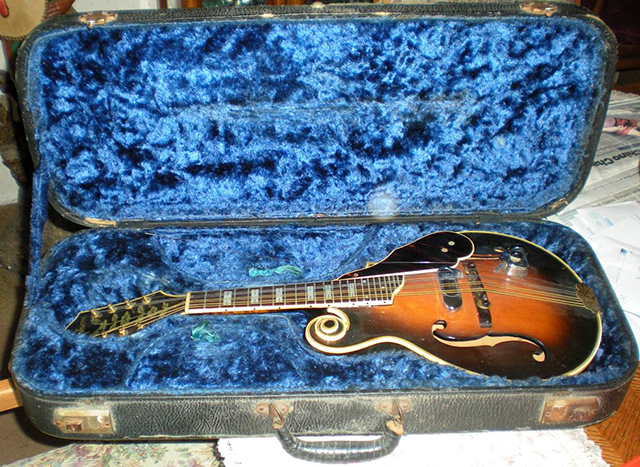
Above: Mandolin case No. 831, keratol covered, form-fitted interior, crushed plush lining, spring locks (with 1940 Windsor); likely manufactured by Lifton; the "E"-logo is hard to see in the curly plush.
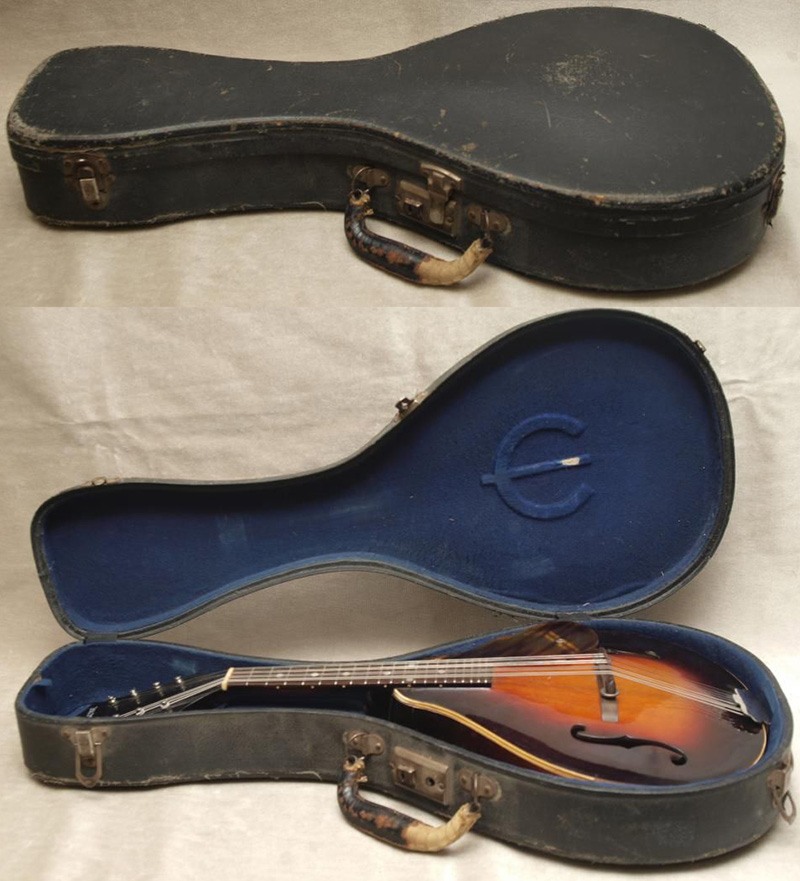
Above: Mandolin case No. 532, keratol covered, fleece lining, no neck rest (with 1940 Adelphi); manufactured by Lifton.
Until 1941, Epiphone electric instruments were sold with the case included (see 1939 catalog picture below). Generally, "E"-logo cases for electric guitars, banjos, lap steels etc. were listed without a model number in catalogs. By 1949 all lap steels came in unbranded cases without "E"-logo.
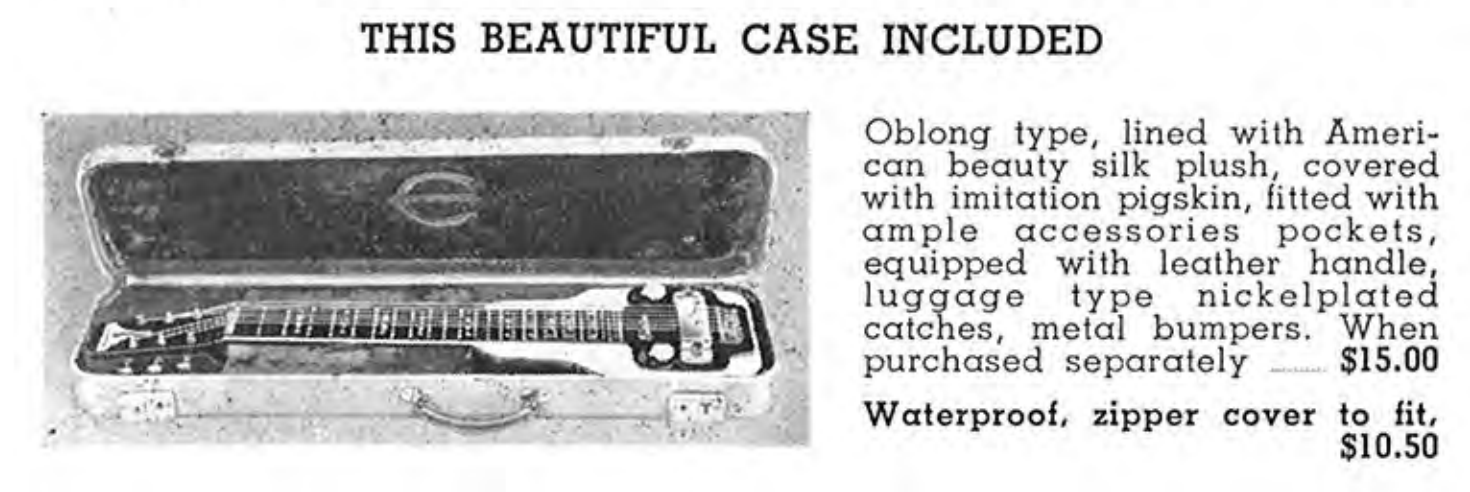
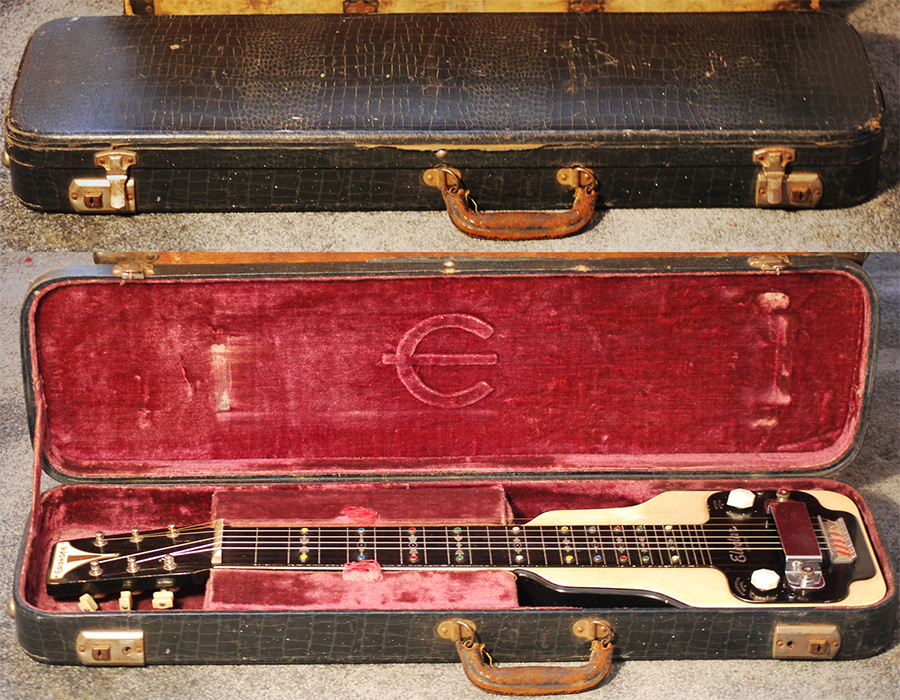
Above: Lap steel case, alligator-style keratol covered, plush lining (with 1941 Zephyr Hawaiian); manufactured by Lifton.
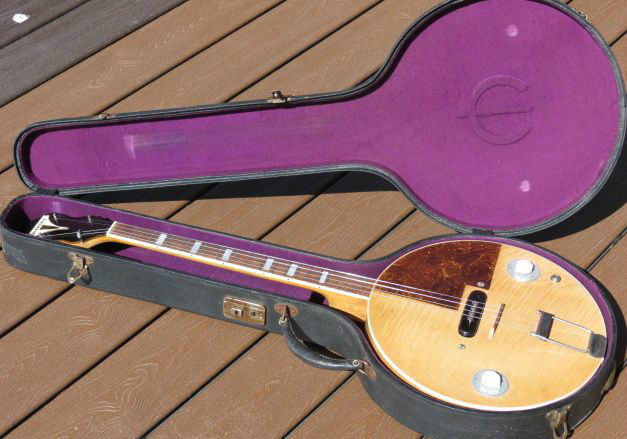
Above: "Masterbilt" series banjo case, keratol covered, fleece lining, no neck rest (with 1940 Zephyr Tenor Banjo); manufactured by Lifton.
Note that in the post-war period Epiphone reduced their case options: For most instrument sizes only one hardshell "E"-logo case model was offered – 18" (No. 110), 16" (No. 884), FT Jumbo (No. 855) and mandolin (No. 632). Exception: For 17" archtops there was a choice between two cases – the standard model No. 885 and the more expensive No. 105 (stitched valance, draw catches).
"E"-logo cases by manufacturer
Like most other musical instrument makers, Epiphone didn't build any cases in-house, but commissioned them from a number of specialized manufacturers who also served other instrument companies such as Gibson, Martin, etc. This subject is being discussed in the highly recommended Vintage Musical Instrument Cases FB group – an invaluable source for the identification of case manufacturers. A big thank you to Steve Kirtley for his groundbreaking musical instrument case research. I will be hyperlinking to Steve's research website in this text a lot.
Based on our image database of Epiphone instruments accompanied by original "E"-logo cases, we can assume that most of them were manufactured by the “big 3" in the American instrument case business of the time: Geib, Harptone and Lifton. Another supplier was Frost & Stone / Stone Case Co.
How can the manufacturer of a case be identified? Often not an easy task, because most "E"-logo cases don't show the name of the manufacturer anywhere (only few examples show a Lifton badge or Harptone label). Therefore, identification of the maker has to be based on a number of typical construction features such as the shape of the case lid arch – see the guide below by Steve Kirtley.
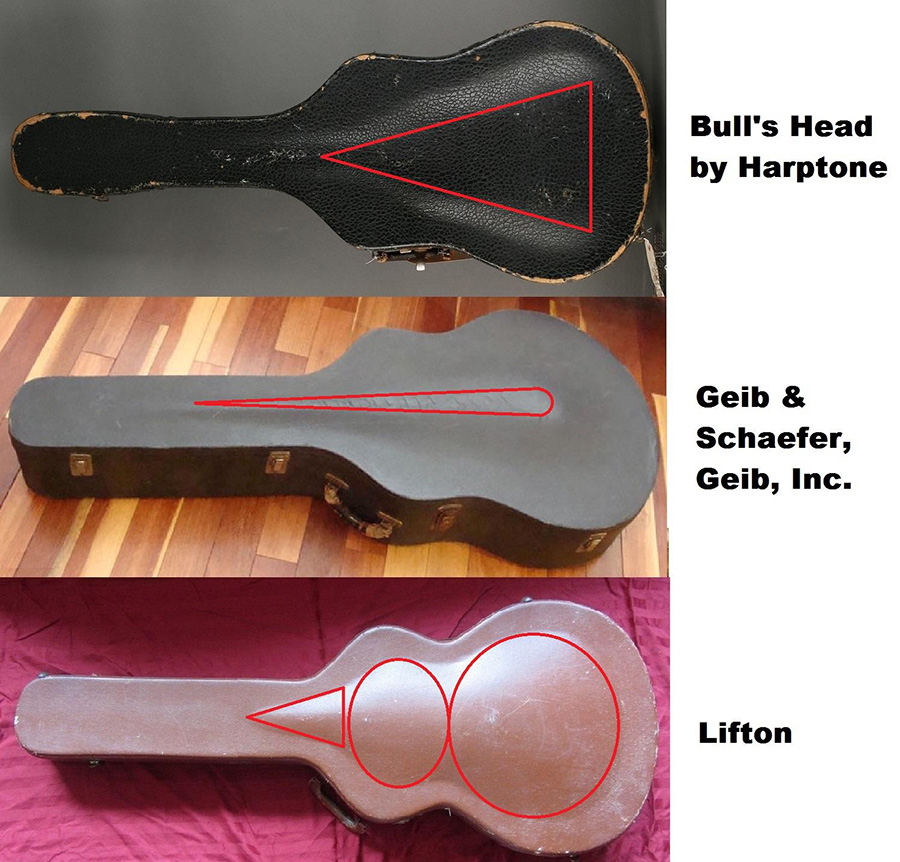
There are a number of other details which help identification – e.g. location and shape of the neck rest, pocket hinge, lining seams, hardware, etc. – but I won't go into too many nerdy details here...
Note that the imitation leather covering varied in color (brown, black) and pattern ("alligator", "spanish leather", etc.). The same applies for the color of the interior lining. Since we see these variations on cases across different manufacturers, they don't help much with their identification.
When comparing the "E"-logos in the lid lining we noticed certain details in the shape and position which seem to be specific to the respective case manufacturers – thus helping their identification:
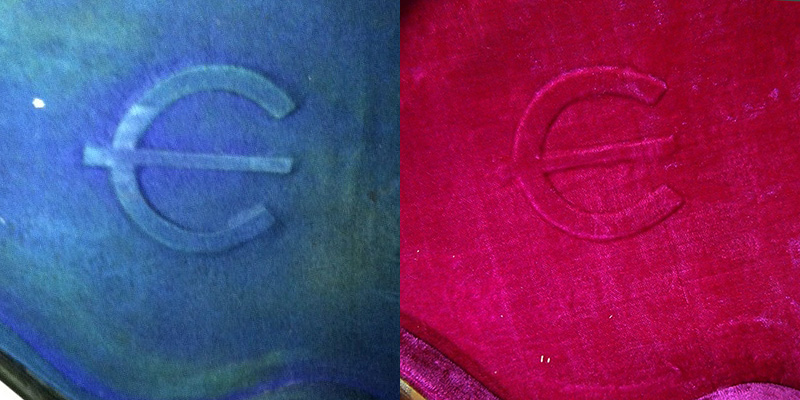
Above: "E"-logo in cases made by Lifton; positioned in the upper bout of the lid; slim horseshoe shape with fairly long crossbar end at the left.
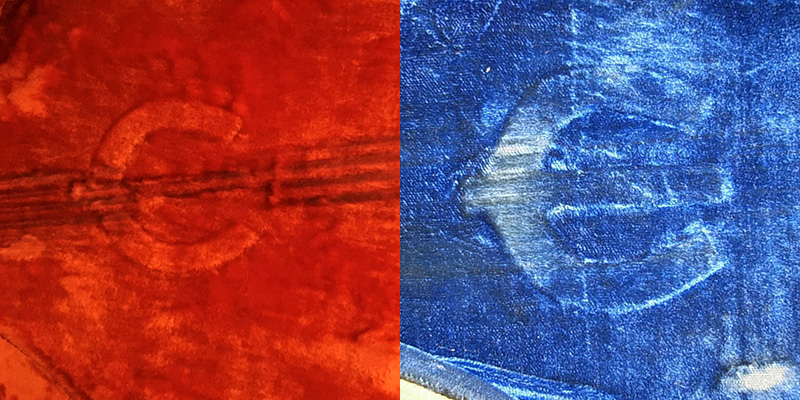
Above: "E"-logo in cases made by Geib; typically positioned in the upper bout of the lid (occasionally in the waist); pronounced, bold horseshoe shape with short crossbar end at the left.
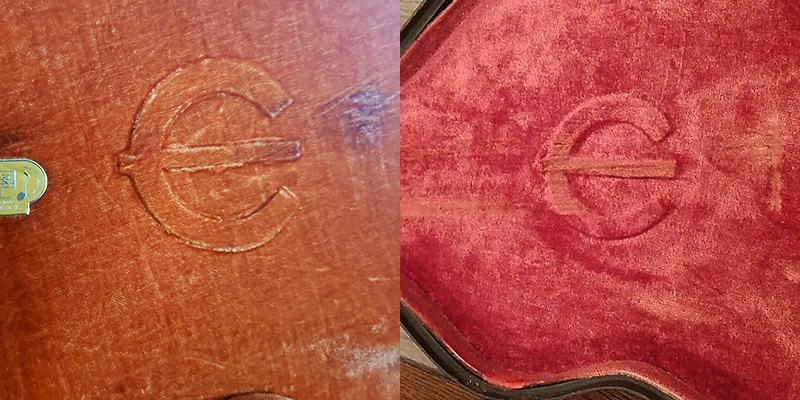
Above: "E"-logo in cases made by Harptone; positioned in the waist area of the lid; circular shape with short crossbar end at the left.
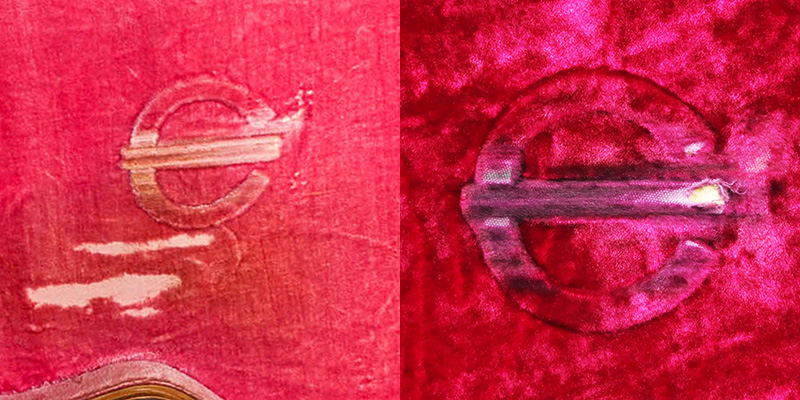
Above: "E"-logo in cases made by Frost & Stone; positioned in the waist area of the lid; circular shape with very small aperture, curved ends almost touching crossbar.
Below a summary of my findings regarding manufacturers of the “E”-logo cases (1939–56), based on documented instruments in the Registry database and my photo library:
1. Lifton Mfg. Co.
The Lifton Manufacturing Company, founded 1918 in New York City NY (factory located in Brooklyn by 1920), became a case supplier for Epiphone around 1935. The vast majority of "E"-logo cases we see showing up can be identified as made by this company: Lifton-made Epiphone hardshell cases can be found over the entire 1939–56 period – in all guitar sizes (18", 17", 16", 15", FT/Hawaiian models) and also for other instrument types. All of the fleece-lined "E"-logo cases (seen until the mid-1940s) appear to be manufactured by Lifton.
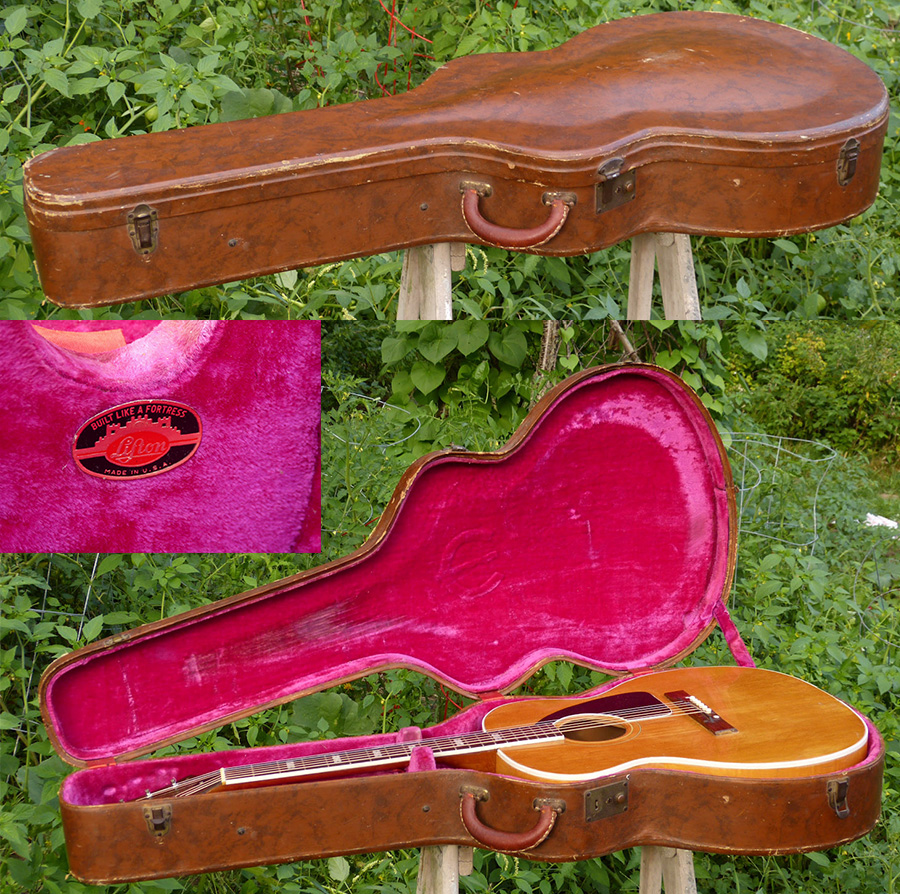
Above: No. 855 case, 16" FT, keratol covered, plush lining, neck rest at heel (with 1955 FT 110); manufactured by Lifton; this example with Lifton badge on the neck rest block; note "8" shape of lid arch; on Lifton cases the "E"-logo is positioned in the upper bout of the lid.
2. Geib, Inc.
Since the 1920s, many hardshell cases for Epiphone instruments were manufactured by the Geib & Schaefer company – founded 1899 in Chicago IL and renamed Geib, Inc. by 1937. Geib seem to have made "E"-logo cases mostly in the large 18" Emperor size – from 1939 until c. 1950. Some Geib-made "E"-logo cases in size 17" have shown up, with instruments from the early '40s – but these seem to be rather uncommon.
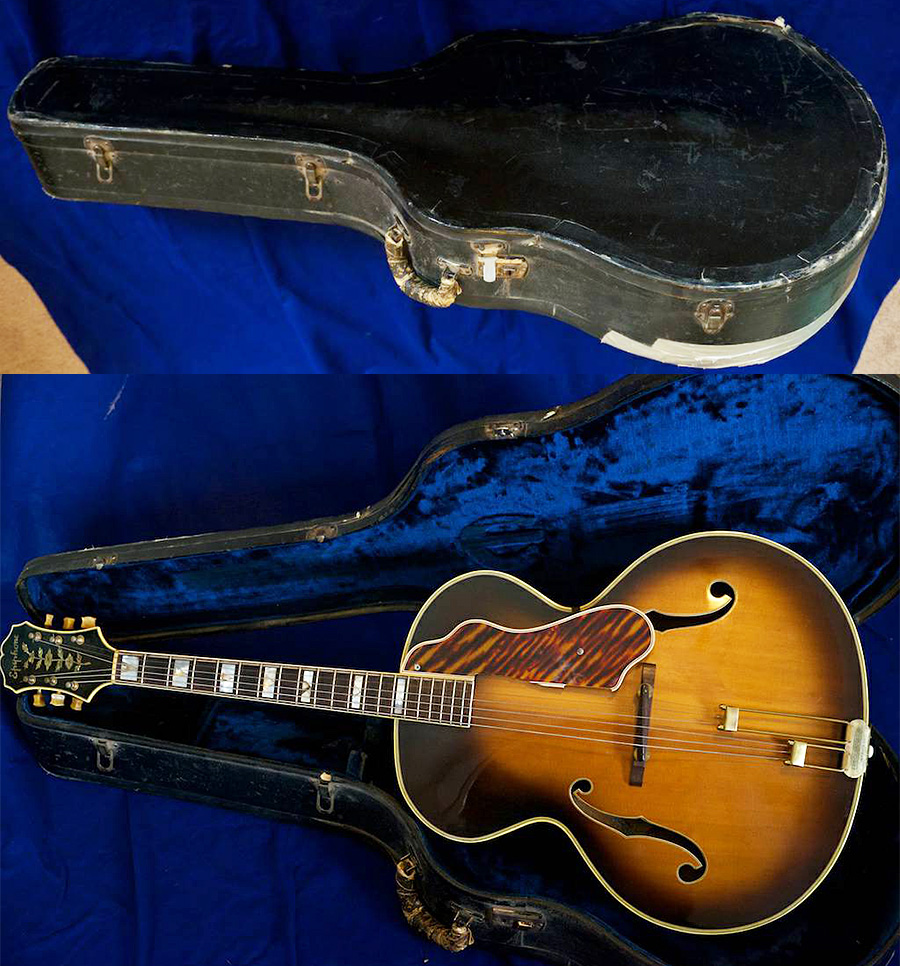
Above: No. 110 case, 18", keratol covered, plush lining, neck rest at heel (with 1946 Emperor); manufactured by Geib; note long, narrow ridge shape of lid arch; on Geib cases the "E"-logo is typically positioned in the upper bout of the lid (rarely in the waist area).
3. Harptone Mfg. Co. ("Bull's Head" brand)
The "Bull's Head" brand of instrument cases goes back to the Maulbetsch & Whittemore Company, founded 1886 in Newark NJ. By 1929 the Harptone Mfg. Co., based in Newark NJ, became the owner of the "Bull's Head" brand. Epiphone had used "Bull's Head" cases since the 1920s. Harptone-made "E"-logo cases show up with instruments from the post-war period only, starting c. 1948 – in archtop guitar sizes 17" and 16".
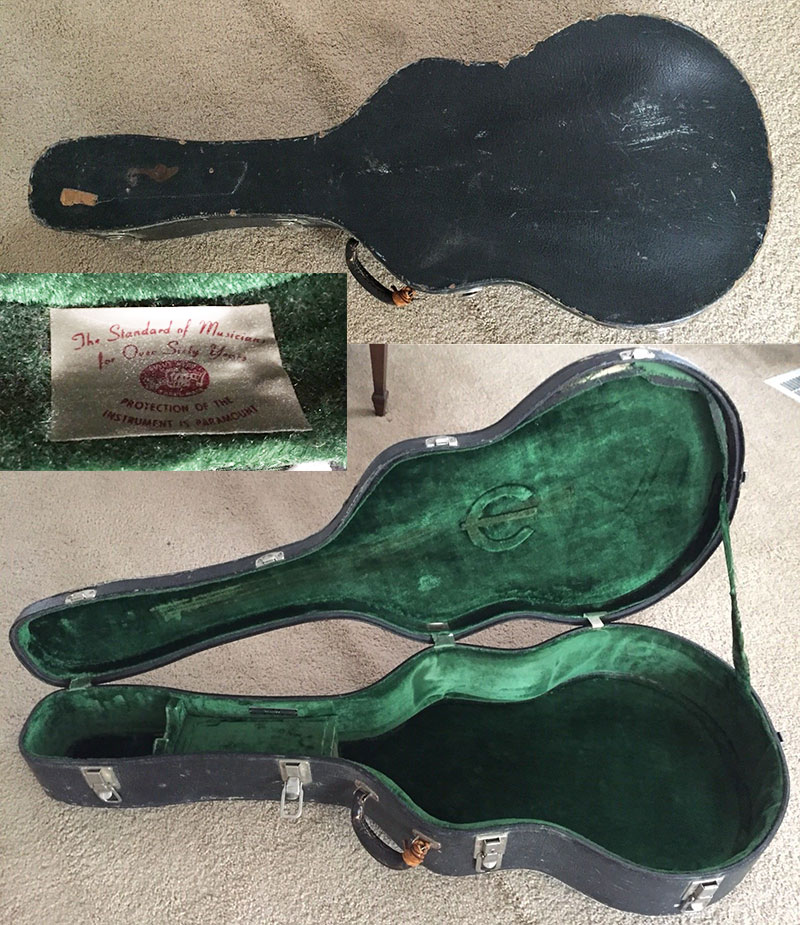
Above: No. 884 case, 16", keratol covered, plush lining, neck rest at headstock, draw catches; manufactured by Harptone, early 1950s; note triangular shape of lid arch. This example bears a label at the middle hinge with Harptone's "Bull's Head" logo and claim "The Standard of Musicians for Over 60 Years" – referring to the brand's start in 1886. On Harptone cases the "E"-logo is placed in the waist area of the lid.
4. Frost & Stone / Stone Case Co.
Finally, there are some "E"-logo cases which appear to be from a different manufacturer than the "big 3" mentioned above – in size 17" only, showing up with instruments from around 1949–50 until the mid-'50s. Their features suggest that they were made by Frost & Stone, located in Brooklyn NY. Case manufacturer Frost & Stone was founded by business partners Max Frost and Abraham Stone in 1913 in NYC. When the company was split after a lawsuit in June 1954, a business named "Stone Case Co." continued to make guitar cases.
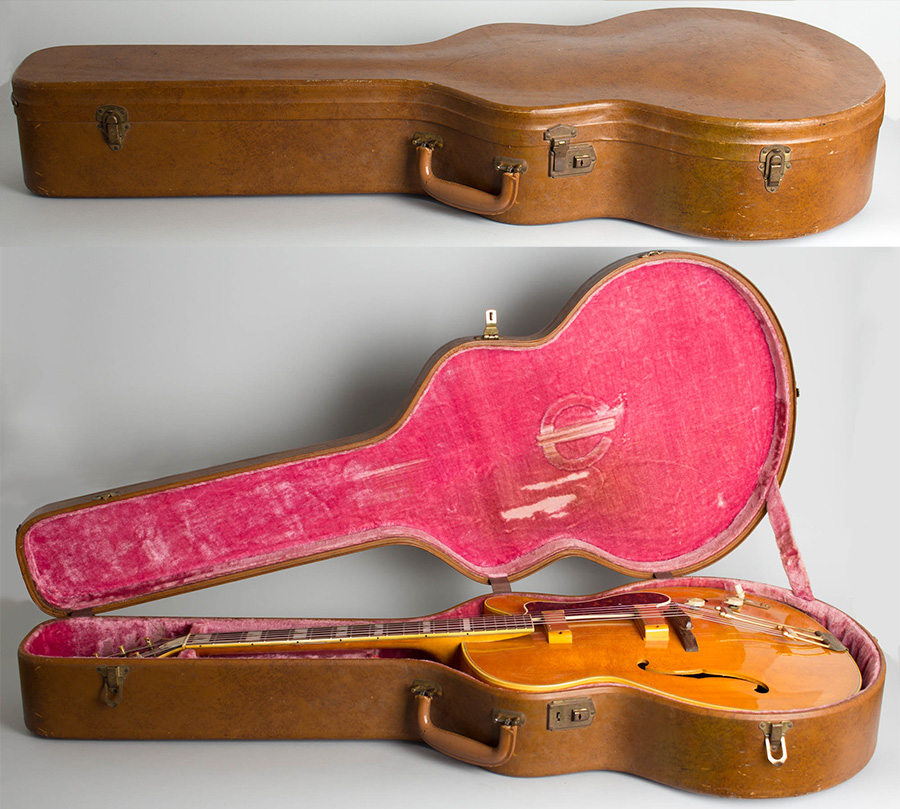
Above: No. 885 case, 17", keratol covered, plush lining, neck rest at headstock (with 1951 Zephyr DeLuxe Regent); manufactured by Frost & Stone; the
low-profile neck rest near the headstock is typical for this maker; note "8" shape of lid arch (somewhat similar to Lifton). On Frost & Stone cases the "E"-logo is positioned in the waist area of the lid.
"E"-logo case models at a glance
| Size | No. | Years | Typical features | Typ. manufacturers |
| 18" | 115 | 1939–46 | plush, genuine leather | Lifton, Geib |
| 18" | 110 | 1946–56 | plush, stitched by '48 | Lifton, Geib |
| 17" | 105 | 1948–56 | plush, stitched valance | Lifton, Harptone, Frost & Stone |
| 17" | 985 | 1941–45 | plush, genuine leather | Lifton |
| 17" | 885 | 1939–56 | plush | Lifton, Geib, Harptone, Frost & Stone |
| 17" | 785 | 1939–41 | fleece, neck rest | Lifton |
| 17" | 685 | 1939–45 | crushed plush | Lifton |
| 17" | 585 | 1939–45 | fleece, no neck rest | Lifton |
| 16" | 884 | 1939–56 | plush | Lifton, Harptone |
| 16" | 684 | 1939–45 | crushed plush | Lifton |
| 16" | 584 | 1939–45 | fleece | Lifton |
| 15" | 683 | 1939–45 | crushed plush | Lifton |
| 15" | 583 | 1939–45 | fleece | Lifton |
| FT 16" | 855 | 1939–56 | plush | Lifton |
| FT 16" | 755 | 1939–42 | crushed plush | Lifton |
| FT 16" | 655 | 1939–42 | fleece | Lifton |
| FT 15" | 637 | 1939–45 | crushed plush | Lifton |
| FT 15" | 537 | 1939–45 | fleece | Lifton |
| FT 14" | 627 | 1939–45 | crushed plush | Lifton |
| FT 14" | 527 | 1939–45 | fleece | Lifton |
| Haw 16" | HA2 | 1939–41 | crushed plush | Lifton |
| Haw 16" | HA1 | 1939–41 | fleece | Lifton |
| Mando | 830 | 1939–42 | oblong, plush | Lifton |
| Mando | 831 | 1939–42 | oblong, crushed plush | Lifton |
| Mando | 632 | 1939–44 | plush | Lifton |
| Mando | 532 | 1939–44 | fleece | Lifton |
| Electric | - | 1939–42 | fleece | Lifton |
| Banjo | - | 1939–42 | fleece | Lifton |
| Steel | - | 1939–42 | plush | Lifton |
| Steel | - | 1939–48 | fleece | Lifton |
More info and pics about individual case models on the Models
page.
Note: This overview is subject to updates whenever new evidence surfaces.
(Dec 13, 2018 – with later updates)